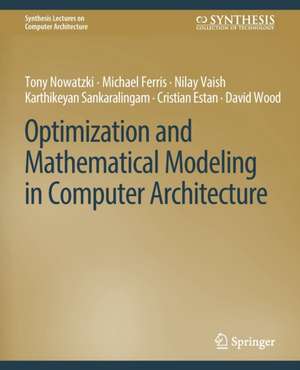Optimization and Mathematical Modeling in Computer Architecture: Synthesis Lectures on Computer Architecture
Autor Karthikeyan Sankaralingam, Michael Ferris, Tony Nowatzki, Cristian Estan, Nilay Vaish, David Wooden Limba Engleză Paperback – 7 oct 2013
Din seria Synthesis Lectures on Computer Architecture
-
 Preț: 359.05 lei
Preț: 359.05 lei - 18%
 Preț: 690.24 lei
Preț: 690.24 lei - 20%
 Preț: 281.76 lei
Preț: 281.76 lei -
 Preț: 453.85 lei
Preț: 453.85 lei -
 Preț: 226.98 lei
Preț: 226.98 lei -
 Preț: 388.52 lei
Preț: 388.52 lei -
 Preț: 353.79 lei
Preț: 353.79 lei -
 Preț: 481.05 lei
Preț: 481.05 lei -
 Preț: 261.32 lei
Preț: 261.32 lei -
 Preț: 413.27 lei
Preț: 413.27 lei -
 Preț: 494.18 lei
Preț: 494.18 lei -
 Preț: 260.56 lei
Preț: 260.56 lei -
 Preț: 194.92 lei
Preț: 194.92 lei -
 Preț: 450.11 lei
Preț: 450.11 lei -
 Preț: 319.21 lei
Preț: 319.21 lei -
 Preț: 449.53 lei
Preț: 449.53 lei -
 Preț: 418.07 lei
Preț: 418.07 lei -
 Preț: 386.22 lei
Preț: 386.22 lei -
 Preț: 486.98 lei
Preț: 486.98 lei -
 Preț: 264.20 lei
Preț: 264.20 lei -
 Preț: 383.71 lei
Preț: 383.71 lei -
 Preț: 346.86 lei
Preț: 346.86 lei -
 Preț: 265.18 lei
Preț: 265.18 lei -
 Preț: 323.45 lei
Preț: 323.45 lei -
 Preț: 260.18 lei
Preț: 260.18 lei -
 Preț: 191.48 lei
Preț: 191.48 lei -
 Preț: 206.29 lei
Preț: 206.29 lei -
 Preț: 205.92 lei
Preț: 205.92 lei -
 Preț: 205.70 lei
Preț: 205.70 lei -
 Preț: 207.06 lei
Preț: 207.06 lei -
 Preț: 260.95 lei
Preț: 260.95 lei -
 Preț: 261.91 lei
Preț: 261.91 lei -
 Preț: 192.63 lei
Preț: 192.63 lei -
 Preț: 262.09 lei
Preț: 262.09 lei -
 Preț: 259.41 lei
Preț: 259.41 lei -
 Preț: 260.95 lei
Preț: 260.95 lei -
 Preț: 456.66 lei
Preț: 456.66 lei -
 Preț: 261.53 lei
Preț: 261.53 lei -
 Preț: 486.42 lei
Preț: 486.42 lei -
 Preț: 210.55 lei
Preț: 210.55 lei -
 Preț: 387.58 lei
Preț: 387.58 lei -
 Preț: 448.38 lei
Preț: 448.38 lei -
 Preț: 264.20 lei
Preț: 264.20 lei -
 Preț: 262.68 lei
Preț: 262.68 lei -
 Preț: 263.06 lei
Preț: 263.06 lei - 20%
 Preț: 288.91 lei
Preț: 288.91 lei -
 Preț: 260.95 lei
Preț: 260.95 lei -
 Preț: 313.82 lei
Preț: 313.82 lei
Preț: 264.41 lei
Nou
Puncte Express: 397
Preț estimativ în valută:
50.61€ • 54.99$ • 42.54£
50.61€ • 54.99$ • 42.54£
Carte tipărită la comandă
Livrare economică 21 aprilie-05 mai
Preluare comenzi: 021 569.72.76
Specificații
ISBN-13: 9783031006456
ISBN-10: 3031006453
Ilustrații: XIV, 144 p.
Dimensiuni: 191 x 235 mm
Greutate: 0.29 kg
Editura: Springer International Publishing
Colecția Springer
Seria Synthesis Lectures on Computer Architecture
Locul publicării:Cham, Switzerland
ISBN-10: 3031006453
Ilustrații: XIV, 144 p.
Dimensiuni: 191 x 235 mm
Greutate: 0.29 kg
Editura: Springer International Publishing
Colecția Springer
Seria Synthesis Lectures on Computer Architecture
Locul publicării:Cham, Switzerland
Cuprins
Acknowledgments.- Introduction.- An Overview of Optimization.- Case Study: Instruction Set Customization.- Case Study: Data Center Resource Management.- Case Study: Spatial Architecture Scheduling.- Case Study: Resource Allocation in Tiled Architectures.- Conclusions.- Bibliography.- Authors' Biographies.
Notă biografică
Karthikeyan Sankaralingam is an Associate Professor at the University of Wisconsin-Madison in the department of computer sciences. He leads the Vertical Research group at UW-Madison, exploring a vertically integrated approach to microprocessor design. His research has developed widely cited results on Dark Silicon, hardware specialization in the DySER architecture, and novel generalizations of GPUs. He is a recipient of the NSF Career Award in 2009 and the IEEE TCCA Young Computer Architect Award in 2011. He is an IEEE Senior Member. He got his PhD and MS from the University of Texas at Austin, and his Bachelor's degree from the Indian Institute of Technology, Madras.
Michael Ferris is a Professor at the University of Wisconsin-Madison in the department of computer sciences. His research is concerned with algorithmic and interface development for large scale problems in mathematical programming, including links to the GAMS and AMPL modeling languages, and general purpose software such as PATH, NLPEC, and EMP. He has worked on several applications of both optimization and complementarity, including cancer treatment plan development, radiation therapy, video-on-demand data delivery, economic and traffic equilibria, structural and mechanical engineering. Ferris is a SIAM fellow and an INFORMS fellow and received the Beale-Orchard-Hays prize from the Mathematical Programming Society and is a past recipient of a NSF Presidential Young Investigator Award, and a Guggenheim Fellowship. He serves on the editorial boards of Mathematical Programming, SIAM Journal on Optimization, Transactions of Mathematical Software, and Optimization Methods and Software.
Tony Nowatzki is a graduate student at the University of Wisconsin-Madison, working as a research assistant in the Vertical Research Group. His research centers around computational accelerators from a design exploration and comparison perspective. Broad interests include architecture and compiler co-design. Heis a student member of IEEE. He has a Bachelor's of Computer Science and Computer Engineering from the University of Minnesota, and a Master's of Computer Science from UW-Madison.
Cristian Estan is an architect at Broadcom Corporation where he works on coprocessors performing critical tasks for networking infrastructure such as packet classification, forwarding lookups and deep packet inspection. He has achieved major reductions in power consumption and cost per bit and increases in functionality through algorithmic and architectural innovation. He has received the Broadcom CEO achievement recognition award (2013), PLDI distinguished paper award (2013), NSF CAREER award (2006), ACSAC best paper award (2006) and UCSD CSE PhD dissertation award (2004). Earlier he worked at NetLogic Microsystems, taught at the CS Department of University of Wisconsin-Madison and had shorter stints at various startups. He published 30 research papers at selective peer-reviewed venues in the fields of computer networking, security, systems, programming languages and databases and is an inventor on 14 patents and patent applications.
